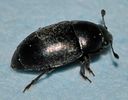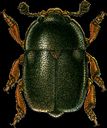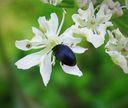Pollen Beetles
Meligethinae
Classification
- Phylum: Arthropoda
- Subphylum: Hexapoda
- Class: Insecta
- Order: Coleoptera
- Suborder: Polyphaga
- Superfamily: Cucujoidea
- Family: Nitidulidae
- Subfamily: Meligethinae
Pronunciation
How to pronounce Meligethinae: /ˌmɛlɪˈɡɛθɪˌniː/
These audio files are automatically generated. While they are not always 100% accurate, they are a good starting point.
Images






Summary
Meligethinae is a subfamily of pollen beetles within the family Nitidulidae, with approximately 6 genera and 10 described species in the region. They are primarily associated with flowering plants and have a unique dietary focus on pollen.
Physical Characteristics
1.5 - 4 mm in length; protibiae with minutely denticulate external edge, appearing smooth if not viewed at a right angle, or clearly denticulate to serrate with up to 12 teeth.
Identification Tips
Large (2.6 - 4 mm), black species; dorsal surface opaque due to crowded puncturation: Meligethes atratus. Body length under 2.6 mm is usually shiny on the dorsal side, often with metallic luster representing Brassicogethes species. Key identification features include the teeth on the protibiae.
Habitat
Meligethinae species are typically found in association with flowering plants, as they are strictly anthophagous (pollen-feeding).
Distribution
Palaearctic and Oriental regions; most diverse in the Afrotropical Region and the warmer parts of Eurasia, poorly represented in the New World.
Diet
Strictly anthophagous, feeding on pollen from various flowering plants. Host specificity is primarily observed during the reproductive season, but flowers are visited intentionally throughout the year.
Life Cycle
Not specifically detailed in the provided information.
Reproduction
Not specifically detailed in the provided information, but involves association with flowering plants for feeding and potentially reproduction.
Ecosystem Role
As pollen feeders, they play a role in pollination and therefore contribute to plant reproduction.
Collecting Methods
- Sweep nets
- Hand collecting from flowers
Preservation Methods
- Pinning
- Ethanol preserves
Evolution
The subfamily Meligethinae has undergone taxonomic rearrangements, with the old genus Meligethes being split into several genera, reflecting diversification processes within this group.
Similar Taxa
Tags
- beetles
- pollen beetles
- Meligethinae
- Nitidulidae
- entomology